The MSI B350 Tomahawk Motherboard Review: Gaming On a Budget
by Gavin Bonshor on March 12, 2018 10:45 AM EST- Posted in
- Motherboards
- AMD
- MSI
- ATX
- Zen
- AM4
- B350
- Ryzen
- Tomahawk
- Raven Ridge
System Performance
Not all motherboards are created equal. On the face of it, they should all perform the same and differ only in the functionality they provide - however, this is not the case. The obvious pointers are power consumption, but also the ability for the manufacturer to optimize USB speed, audio quality (based on audio codec), POST time and latency. This can come down to manufacturing process and prowess, so these are tested.
Power Consumption
Power consumption was tested on the system while in a single ASUS GTX 980 GPU configuration with a wall meter connected to the Thermaltake 1200W power supply. This power supply has ~75% efficiency > 50W, and 90%+ efficiency at 250W, suitable for both idle and multi-GPU loading. This method of power reading allows us to compare the power management of the UEFI and the board to supply components with power under load, and includes typical PSU losses due to efficiency. These are the real world values that consumers may expect from a typical system (minus the monitor) using this motherboard.
While this method for power measurement may not be ideal, and you feel these numbers are not representative due to the high wattage power supply being used (we use the same PSU to remain consistent over a series of reviews, and the fact that some boards on our test bed get tested with three or four high powered GPUs), the important point to take away is the relationship between the numbers. These boards are all under the same conditions, and thus the differences between them should be easy to spot.
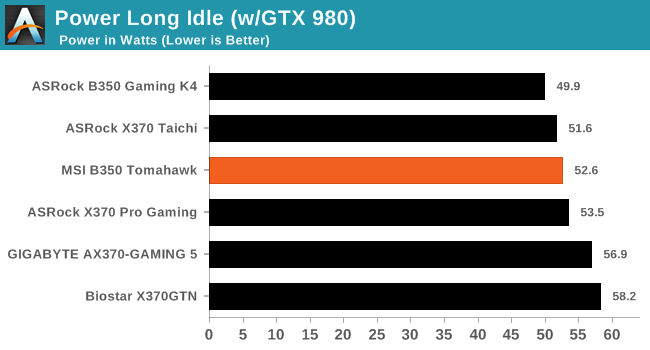

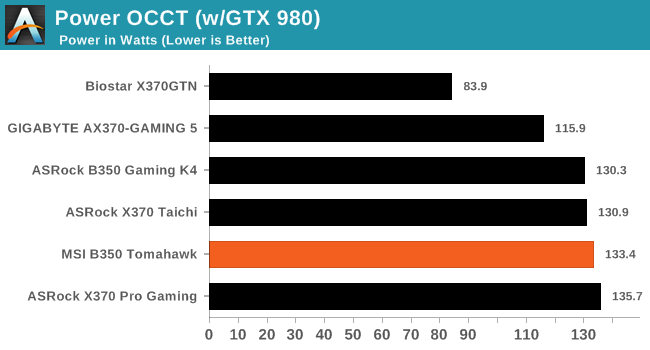
On the whole when compared to the other X370/B350 motherboards on test, the MSI B350 Tomahawk sits relatively average. At load however, there are no real advantages to being a budget B350 board.
Non-UEFI POST Time
Different motherboards have different POST sequences before an operating system is initialized. A lot of this is dependent on the board itself, and POST boot time is determined by the controllers on board (and the sequence of how those extras are organized). As part of our testing, we look at the POST Boot Time using a stopwatch. This is the time from pressing the ON button on the computer to when Windows starts loading. (We discount Windows loading as it is highly variable given Windows specific features.)
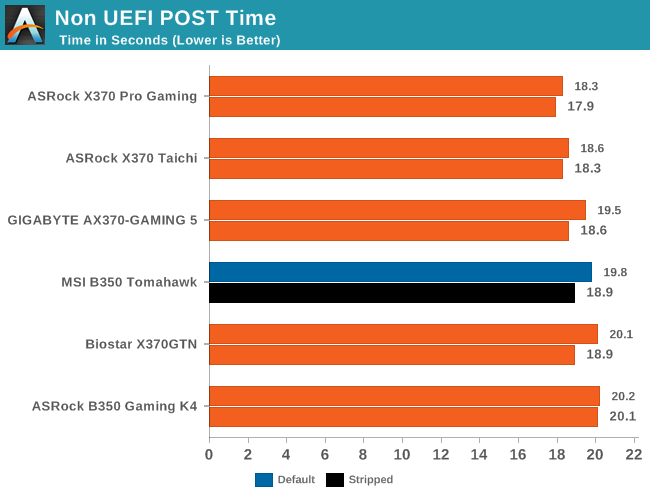
Most of the POST times on X370 seem to be in the same ball-park, differing by a second or two for the most part.
Rightmark Audio Analyzer 6.2.5
Rightmark:AA indicates how well the sound system is built and isolated from electrical interference (either internally or externally). For this test we connect the Line Out to the Line In using a short six inch 3.5mm to 3.5mm high-quality jack, turn the OS speaker volume to 100%, and run the Rightmark default test suite at 192 kHz, 24-bit. The OS is tuned to 192 kHz/24-bit input and output, and the Line-In volume is adjusted until we have the best RMAA value in the mini-pretest. We look specifically at the Dynamic Range of the audio codec used on the rear panel of the board.
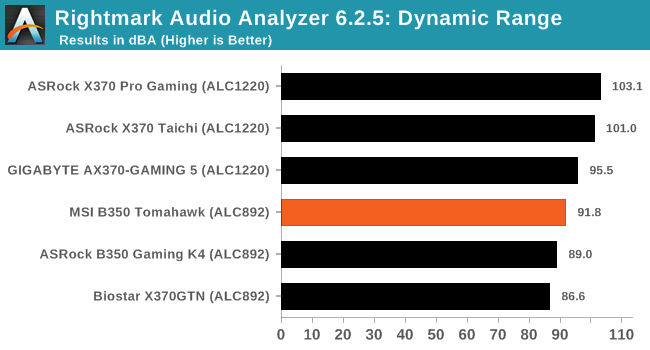
In an expected showing, the Realtek ALC892 comes reasonably close to the ALC1220 options, but can't hit the high.
DPC Latency
Deferred Procedure Call latency is a way in which Windows handles interrupt servicing. In order to wait for a processor to acknowledge the request, the system will queue all interrupt requests by priority. Critical interrupts will be handled as soon as possible, whereas lesser priority requests such as audio will be further down the line. If the audio device requires data, it will have to wait until the request is processed before the buffer is filled.
If the device drivers of higher priority components in a system are poorly implemented, this can cause delays in request scheduling and process time. This can lead to an empty audio buffer and characteristic audible pauses, pops and clicks. The DPC latency checker measures how much time is taken processing DPCs from driver invocation. The lower the value will result in better audio transfer at smaller buffer sizes. Results are measured in microseconds.
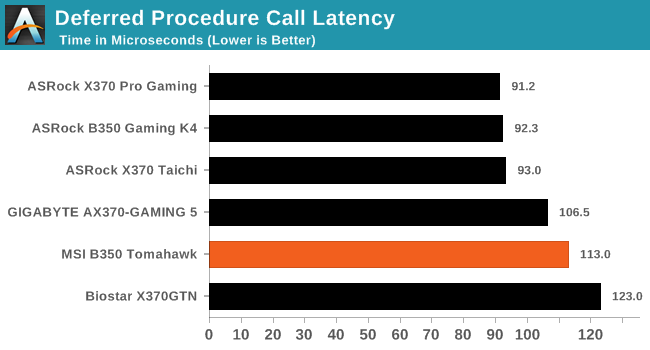
None of the boards tested thus far have been optimised for DPC latency, although all of the test boards managed to squeeze under 150 microseconds with relative ease. The B350 Tomahawk does fall behind from the ASRock boards in our testing by around 21 microseconds; not a massive difference in real world scenarios however.










46 Comments
View All Comments
vkristof - Tuesday, March 13, 2018 - link
yeah: this has been driving me nuts.Many B350 motherboards do not list the full complement of TWO (2) USB 3.1 Gen ports that AMD states the chipset/FCH/whatever provides. Are there additional components that have to be added to the B350 to get the Gen2 speed to work?
unlockproject - Monday, August 1, 2022 - link
sometimes windowless chttp://sharepoint.bath.k12.va.us/tech/forum/Lists/...
Tsavo - Monday, March 12, 2018 - link
I have the Krait version of this. It takes forever (15s) to POST. Latest BIOS doesn't fix it, either.Other than that massive clanger, it's an ok board, but I'd certainly not recommend any AMD based MSI board based upon the long POST time.
artifex - Monday, March 12, 2018 - link
My MSI 970a-g43 (AM3+) hits the Windows login screen in about 5 seconds.I wonder what's happened between then and now, design-wise? Especially since mine's not a "gaming" board and I got it for about $30-40.
kepstin - Monday, March 12, 2018 - link
The change to DDR 4 ram hurt motherboard post times a fair bit. And the am4 boards, particularly with early bioses, might put you into a slow ram setup retry loop.That said, with the latest (1.C) bios on my tomahawk, and with Windows whql mode enabled (turns off legacy boot), I have nothing to complain about with post speed.
Tsavo - Monday, March 12, 2018 - link
I think you may be on to something here. I've been poking around, and found out that the BIOS of my GTX 660 doesn't support UEFI fast boot. I emailed EVGA for an updated version that supports it.Dollars to donuts, the UEFI bios is looking for signed devices and takes a long time to do it if it comes across ones that aren't.
artifex - Monday, March 12, 2018 - link
Yikes. Guess I should be looking for an update to that situation when the 450/470-based boards come out, before deciding to upgrade.TrackSmart - Monday, March 12, 2018 - link
Why the long post times for all of these modern motherboards? I thought my Ryzen motherboard was just poorly optimized (about 20 seconds to post; Also 20 seconds to wake from sleep). But it looks like this is one area where desktop motherboards have *not* improved performance-wise in the past 8 years.My 2010-era AMD system posts faster than my new Ryzen build. And it wakes from sleep in about 4-5 seconds instead of ~20 seconds. That is after all efforts to streamline the post times. My ~1 second improvement in post time mirrors the difference between "stripped" and "default" in this article, so I'm guessing that there's not a lot of improvement to be had, short of optimizations from the motherboard manufacturer themselves (ASUS in my case).
silverblue - Wednesday, March 14, 2018 - link
My Gigabyte GA-AB350 Gaming 3 has three Fast BIOS speed settings - Disabled, Enabled and Ultra Fast. The latter doesn't even show the BIOS before you get the Windows 10 logo, not a massive issue if you're happy with the APP Center within Windows instead of being able to go the BIOS directly.silverblue - Wednesday, March 14, 2018 - link
Yep, 9 seconds from on to Windows 10 logo, and another 5 to login screen. About 5 seconds from sleep (though some of that is the display turning back on). I should also explain that I have a Samsung 850 Evo 250GB as my boot drive, and that I'm running a Ryzen 5 1600 with 16GB DDR4 3000 CL16.